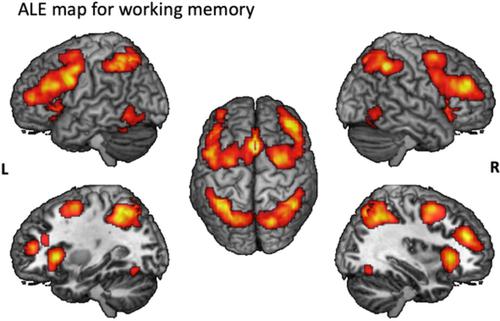当前位置:
X-MOL 学术
›
Hum. Brain Mapp.
›
论文详情
Our official English website, www.x-mol.net, welcomes your
feedback! (Note: you will need to create a separate account there.)
Do intrinsic brain functional networks predict working memory from childhood to adulthood?
Human Brain Mapping ( IF 3.5 ) Pub Date : 2020-07-30 , DOI: 10.1002/hbm.25143 Han Zhang 1, 2 , Shuji Hao 2 , Annie Lee 1 , Simon B Eickhoff 3, 4 , Diliana Pecheva 1 , Shirong Cai 5 , Michael Meaney 5 , Yap-Seng Chong 5, 6 , Birit F P Broekman 7 , Marielle V Fortier 8 , Anqi Qiu 1, 9
Human Brain Mapping ( IF 3.5 ) Pub Date : 2020-07-30 , DOI: 10.1002/hbm.25143 Han Zhang 1, 2 , Shuji Hao 2 , Annie Lee 1 , Simon B Eickhoff 3, 4 , Diliana Pecheva 1 , Shirong Cai 5 , Michael Meaney 5 , Yap-Seng Chong 5, 6 , Birit F P Broekman 7 , Marielle V Fortier 8 , Anqi Qiu 1, 9
Affiliation

|
Working memory (WM) is defined as the ability to maintain a representation online to guide goal‐directed behavior. Its capacity in early childhood predicts academic achievements in late childhood and its deficits are found in various neurodevelopmental disorders. We employed resting‐state fMRI (rs‐fMRI) of 468 participants aged from 4 to 55 years and connectome‐based predictive modeling (CPM) to explore the potential predictive power of intrinsic functional networks to WM in preschoolers, early and late school‐age children, adolescents, and adults. We defined intrinsic functional networks among brain regions identified by activation likelihood estimation (ALE) meta‐analysis on existing WM functional studies (ALE‐based intrinsic functional networks) and intrinsic functional networks generated based on the whole brain (whole‐brain intrinsic functional networks). We employed the CPM on these networks to predict WM in each age group. The CPM using the ALE‐based and whole‐brain intrinsic functional networks predicted WM of individual adults, while the prediction power of the ALE‐based intrinsic functional networks was superior to that of the whole‐brain intrinsic functional networks. Nevertheless, the CPM using the whole‐brain but not the ALE‐based intrinsic functional networks predicted WM in adolescents. And, the CPM using neither the ALE‐based nor whole‐brain networks predicted WM in any of the children groups. Our findings showed the trend of the prediction power of the intrinsic functional networks to cognition in individuals from early childhood to adulthood.
中文翻译:

大脑内在功能网络是否可以预测从童年到成年的工作记忆?
工作记忆(WM)被定义为在线维持表征以指导目标导向行为的能力。它在儿童早期的能力预示着儿童后期的学业成就,而其缺陷则存在于各种神经发育障碍中。我们采用 468 名 4 至 55 岁参与者的静息态功能磁共振成像 (rs-fMRI) 和基于连接组的预测模型 (CPM) 来探索内在功能网络对学龄前儿童、学龄早期和晚期 WM 的潜在预测能力儿童、青少年和成人。我们定义了通过现有 WM 功能研究(基于 ALE 的内在功能网络)的激活似然估计(ALE)元分析识别的大脑区域之间的内在功能网络和基于整个大脑生成的内在功能网络(全脑内在功能网络) 。我们在这些网络上使用 CPM 来预测每个年龄组的 WM。使用基于 ALE 的全脑内在功能网络的 CPM 预测了成人个体的 WM,而基于 ALE 的内在功能网络的预测能力优于全脑内在功能网络。尽管如此,CPM 使用全脑而不是基于 ALE 的内在功能网络来预测青少年的 WM。而且,CPM 既不使用基于 ALE 的网络,也不使用全脑网络来预测任何儿童组的 WM。我们的研究结果显示了内在功能网络对个体从幼儿期到成年期认知的预测能力的趋势。
更新日期:2020-07-30
中文翻译:

大脑内在功能网络是否可以预测从童年到成年的工作记忆?
工作记忆(WM)被定义为在线维持表征以指导目标导向行为的能力。它在儿童早期的能力预示着儿童后期的学业成就,而其缺陷则存在于各种神经发育障碍中。我们采用 468 名 4 至 55 岁参与者的静息态功能磁共振成像 (rs-fMRI) 和基于连接组的预测模型 (CPM) 来探索内在功能网络对学龄前儿童、学龄早期和晚期 WM 的潜在预测能力儿童、青少年和成人。我们定义了通过现有 WM 功能研究(基于 ALE 的内在功能网络)的激活似然估计(ALE)元分析识别的大脑区域之间的内在功能网络和基于整个大脑生成的内在功能网络(全脑内在功能网络) 。我们在这些网络上使用 CPM 来预测每个年龄组的 WM。使用基于 ALE 的全脑内在功能网络的 CPM 预测了成人个体的 WM,而基于 ALE 的内在功能网络的预测能力优于全脑内在功能网络。尽管如此,CPM 使用全脑而不是基于 ALE 的内在功能网络来预测青少年的 WM。而且,CPM 既不使用基于 ALE 的网络,也不使用全脑网络来预测任何儿童组的 WM。我们的研究结果显示了内在功能网络对个体从幼儿期到成年期认知的预测能力的趋势。











































 京公网安备 11010802027423号
京公网安备 11010802027423号